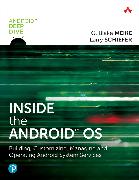RésuméInside the Android OS is the first comprehensive guide and reference for developers who want to customise and integrate Android into their own embedded devices. Replete with code examples, it encourages you to create your own working code versions as you read -- whether for your own personal insight or for a workplace project in the fast-growing marketplace for non-phone Android devices.
G. Blake Meike responds to the real-world needs of embedded and IoT developers moving to Android, providing indispensable information without becoming obscure or too specialised. Meike teaches through a book-length project that covers everything developers need to know to create their own custom Android service. You will find approachable yet precise coverage of:
Why Android is becoming a pervasive embedded platform
Using the Android four-tier architectural model in embedded devices
Setting up a build platform, downloading the AOSP source, and building an Android image
Walking through system startup on a running Android system
Running native services on embedded systems
Using the Android Native Development Kit (NDK) and HAL to link interpreted Java with native C/C++ code
Taking a deep dive into the seminal Zygote application and its Dalvik interpreter
Quickly building Java system services
Working with Binder, the heart and the root of the Android security and access control models
Establishing permissions and access control
Enabling apps to use the services you have created
RésuméThe Complete Guide to Customizing Android for New IoT and Embedded Devices
Inside the Android OS is a comprehensive guide and reference for technical professionals who want to customize and integrate Android into embedded devices, and construct or maintain successful Android-based products. Replete with code examples, it encourages you to create your own working code as you read---whether for personal insight or a professional project in the fast-growing marketplace for smart IoT devices.
Expert Android developers G. Blake Meike and Larry Schiefer respond to the real-world needs of embedded and IoT developers moving to Android. After presenting an accessible introduction to the Android environment, they guide you through boot, subsystem startup, hardware interfaces, and application support---offering essential knowledge without ever becoming obscure or overly specialized.
Reflecting Android's continuing evolution, Meike and Schiefer help you take advantage of relevant innovations, from the ART application runtime environment to Project Treble. Throughout, a book-length project covers all you need to start implementing your own custom Android devices, one step at a time.
You will:
Assess advantages and tradeoffs using Android in smart IoT devices
Master practical processes for customizing Android
Set up a build platform, download the AOSP source, and build an Android image
Explore Android's components, architecture, source code, and development tools
Understand essential kernel modules that are unique to Android
Use Android's extensive security infrastructure to protect devices and users
Walk through Android boot, from power-on through system initialization
Explore subsystem startup, and use Zygote containers to control application processes
Interface with hardware through Android's Hardware Abstraction Layer (HAL)
Provide access to Java programs via Java Native Interface (JNI)
Gain new flexibility by using binderized HAL (Project Treble)
Implement native C/C++ or Java client apps without bundling vendor libraries

